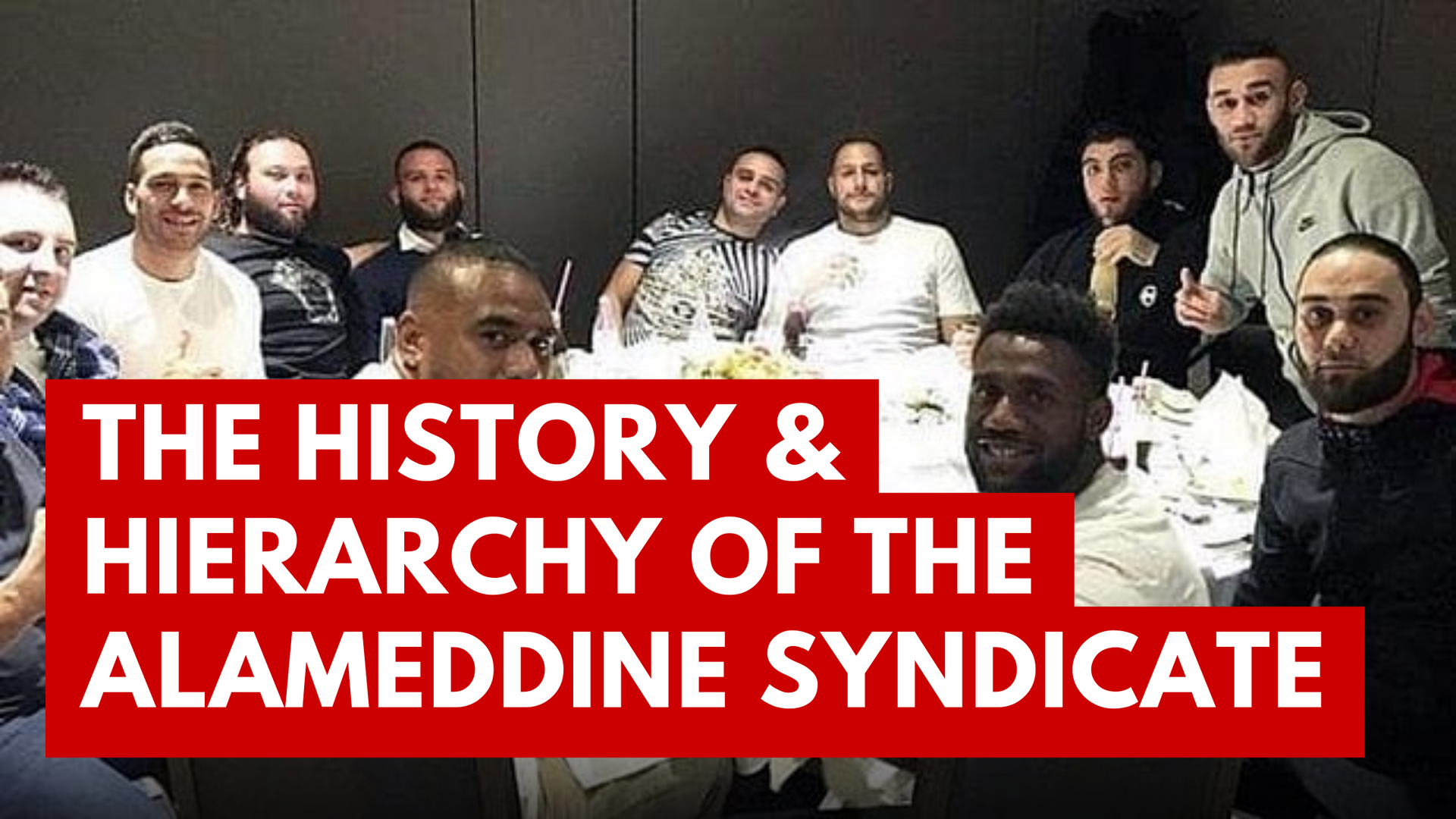Inside the Alameddine Syndicate: Sydney's Most Feared Criminal Empire Exposed!

Introduction
In recent months, the city of Sydney has witnessed a disturbing rise in gang-related violence, leaving residents on edge and authorities grappling for solutions. At the heart of this tumultuous wave is the Alameddine Syndicate, a formidable criminal network that has become synonymous with the chaos unfolding on the city's streets.
As one of the most influential entities in the underworld, the syndicate's operations are far-reaching and deeply entrenched in illicit activities. To understand the current landscape of organized crime in Sydney, it is crucial to delve into the history and hierarchy of the Alameddine Syndicate.
This article aims to uncover the roots of this notorious organization, shedding light on its origins, internal structure, and the significant role it plays in the ongoing gangland conflicts.
Origins of the Alameddine Syndicate
Historical Background
The Alameddine Syndicate emerged in the late 1990s as a formidable force within Sydney's criminal underworld. Its roots can be traced back to the western suburbs, where socio-economic challenges provided fertile ground for organized crime. During this period, the syndicate began establishing its influence, driven by a desire to control lucrative criminal enterprises.
Founding Members and Initial Operations
The syndicate was spearheaded by a group of ambitious individuals, many of whom had familial ties that strengthened their unity. This close-knit circle of founders laid the groundwork for what would become a significant criminal empire. Initially, the syndicate focused on smaller-scale operations, including local drug distribution and protection rackets, which allowed them to amass wealth and power.
As their operations expanded, so did their reach, eventually positioning the Alameddine Syndicate as a dominant player in Sydney's illegal activities. This strategic growth set the stage for their future endeavors, influencing the city's criminal landscape for decades to come.
Organizational Structure
The Alameddine Syndicate operates under a well-defined hierarchy, akin to a corporate structure, ensuring efficiency and control over its illegal enterprises.
At the top of the pyramid sits the syndicate's leader, often a family member, who orchestrates the overarching strategies and maintains alliances with other criminal entities. This figure is pivotal in decision-making and steering the syndicate's direction.
Beneath the leader, the second tier comprises senior lieutenants. These key figures are tasked with managing day-to-day operations, including overseeing drug distribution networks and handling financial transactions. They act as intermediaries between the leader and the lower ranks, ensuring commands are executed seamlessly.
The third level consists of enforcers and street-level operatives. Enforcers are responsible for maintaining order, instilling discipline, and managing potential threats to the syndicate's power. Street-level operatives handle the ground operations, such as drug sales and gathering intelligence, vital for the syndicate's sustenance.
This structured hierarchy, detailed in the flowchart below, allows the Alameddine Syndicate to operate with military-like precision, adapting to challenges while maintaining its stronghold in Sydney's criminal underworld.
Criminal Activities
The Alameddine Syndicate has established itself as a formidable force within Sydney's criminal landscape, primarily through its extensive involvement in drug trafficking. Leveraging a sophisticated network, the syndicate is believed to control a significant portion of the city's illegal drug market.
Reports suggest that the syndicate's drug operations generate millions in revenue annually, with methamphetamine and cocaine being the most trafficked substances.
Beyond drug trafficking, the Alameddine Syndicate engages in a range of other illegal activities, with extortion being particularly prominent.
Businesses across the city have reportedly been coerced into paying protection money to avoid violent retribution. This systematic extortion contributes significantly to the syndicate's financial resources, enabling further expansion of their criminal enterprises.
In addition, the syndicate partakes in arms smuggling and money laundering, which not only bolster their economic power but also enhance their operational capabilities. These illegal activities, deeply embedded in the syndicate's operations, highlight the complex and multi-faceted nature of their criminal undertakings, posing significant challenges for law enforcement agencies aiming to dismantle their influence.
Recent Shooting on Granville Street
On a fateful evening in late September, Granville Street became the backdrop for a violent scene that has since sent shockwaves through Sydney.
At approximately 8 PM, gunfire erupted, leaving a prominent crime figure and his lawyer critically injured. The attack, carried out by unknown assailants, was swift and precise, suggesting a well-coordinated operation.
The crime figure, identified as a high-ranking member of the Alameddine Syndicate, has long been under investigation for his alleged involvement in drug trafficking and extortion. His lawyer, known for defending high-profile criminal cases, was also targeted, raising questions about the motive behind the attack.
Witnesses described the chaos, with one bystander recounting, "It happened so fast; I heard gunshots and saw people running in every direction."
This brazen attack has heightened fears of an escalating gangland war in Sydney. Law enforcement officials are intensifying efforts to identify the perpetrators and understand the underlying motives. As investigations continue, the incident underscores the ongoing violence and power struggles within Sydney's criminal underworld.
Potential Motives Behind the Attack
The recent shooting on Granville Street has left many speculating about the intentions behind such a bold attack. One prevailing theory suggests that the incident was a retaliatory measure, linked to the ongoing power struggle within the Sydney gangland scene. Experts point to the Alameddine Syndicate's recent territorial expansions as a possible catalyst for such violent confrontations.
Another theory posits that internal strife within the syndicate could have led to the attack. According to a senior detective familiar with the case, "When power dynamics shift within these organizations, it often leads to internal conflicts that can quickly turn deadly." The targeted crime figure's high-ranking status within the Alameddine network supports the notion that this attack could be an attempt to disrupt the syndicate's hierarchy.
Regardless of the precise motive, the implications for Sydney's ongoing turf wars are significant. The attack signifies a potential escalation in violence, prompting concerns about further retaliations.
As law enforcement grapples with these developments, the city's communities remain on edge, wary of becoming collateral damage in this fierce criminal rivalry.
Impact on the Community
The recent surge in gang violence attributed to the Alameddine Syndicate has left a mark on Sydney's local communities, instilling fear and uncertainty among residents. Streets once considered safe have become battlegrounds, with families caught in the crossfire. "We used to feel secure in our neighborhood," lamented one local resident, "but now, every loud noise makes us anxious." The pervasive threat of violence has disrupted daily life, affecting businesses and community events.
In response, city officials and law enforcement have ramped up efforts to restore peace. Increased police patrols and community outreach programs aim to reassure residents and gather crucial intelligence. Detective Senior Sergeant Mark Phillips emphasized, "Our goal is to dismantle these criminal networks and return safety to our neighborhoods."
Community initiatives have also emerged, focusing on fostering youth engagement and offering alternative paths away from crime. Local non-profits are actively involved, providing mentorship and activities designed to build resilience. These measures, while promising, highlight the complex challenge of addressing the root causes of gang violence and restoring a sense of normalcy to affected areas.
Law Enforcement Perspective
In the ongoing battle against the Alameddine Syndicate, law enforcement officials face a formidable adversary. Interviews with police officers and detectives reveal the depth of the challenges in dismantling such a well-entrenched criminal network. Detective Inspector James Carter noted, "These groups operate with a level of sophistication that makes them difficult to penetrate."
One of the primary challenges is the syndicate's elusive nature. Its members are adept at evading detection through encrypted communications and a strict code of silence, making intelligence gathering arduous. "The lack of cooperation from insiders means we're often working in the dark," admitted Detective Carter.
Furthermore, the syndicate's influence extends beyond Sydney, complicating jurisdictional efforts. The international links and financial backing of the syndicate require cross-border collaboration, which can be slow and mired in red tape.
Despite these hurdles, law enforcement remains committed to its mission. "Our priority is to disrupt their operations and bring those responsible to justice," emphasized Officer Sarah Martinez, highlighting the ongoing dedication to curb the syndicate's reach and restore safety to affected communities.
Legal System and the Syndicate
The justice system has encountered numerous complexities in prosecuting the Alameddine Syndicate, a group renowned for its sophisticated criminal operations. Notable cases include the 2018 trial of key syndicate members, which resulted in several convictions for drug trafficking and money laundering. However, these successes are often overshadowed by the syndicate's ability to exploit legal loopholes.
In a 2020 case, charges against a prominent syndicate figure were dismissed due to insufficient evidence, illustrating the challenges faced by prosecutors. Despite significant police efforts, the syndicate's use of encrypted communications and offshore accounts frequently complicates the collection of definitive proof.
Data suggests that while there have been over 50 arrests linked to the syndicate in recent years, the conviction rate remains low. Legal experts point to procedural delays and the syndicate's high-caliber legal defense as key obstacles. The ongoing struggle underscores the need for legislative reforms to address these loopholes and fortify the legal framework against organized crime. As the legal system grapples with these challenges, the community continues to call for more effective strategies to dismantle the syndicate's influence.
Public Perception and Media Portrayal
The Alameddine Syndicate is often viewed by the public through a lens of fear and intrigue, a sentiment largely influenced by media portrayal. Public opinion polls indicate that a significant portion of Sydney's residents, approximately 70%, express concern over the syndicate's impact on local safety and community wellbeing. This apprehension is further fueled by high-profile media coverage that often highlights the syndicate's involvement in violent crimes and illicit activities.
News outlets frequently emphasize dramatic and sensational aspects of the syndicate's operations, sometimes overshadowing the complexities of the underlying issues. The media's focus on high-stakes incidents, such as the recent Granville Street shooting, tends to amplify public fear and perceptions of lawlessness.
While the media plays a crucial role in informing the public, critics argue that coverage can sometimes lack depth, opting for headlines that capture attention but may not provide comprehensive context. This portrayal can inadvertently shape public perception, casting a shadow over initiatives aimed at understanding and resolving the root causes of organized crime in Sydney. As the city grapples with these challenges, balanced reporting remains essential to foster informed public discourse.
Future of Gangland Wars in Sydney
As the city grapples with escalating violence, experts predict that Sydney's gangland wars could intensify if left unchecked. The power struggles among syndicates like the Alameddine Syndicate are expected to continue, driven by the lucrative opportunities in drug trafficking and other illegal ventures. Analysts warn that without strategic intervention, these conflicts could further destabilize the region and increase the risk of collateral damage to innocent civilians.
However, there are potential resolutions on the horizon. Law enforcement agencies are ramping up efforts to dismantle organized crime networks through enhanced surveillance and intelligence-gathering techniques. Some experts suggest that fostering community engagement and development programs could address the socio-economic roots of gang recruitment, thereby reducing the allure of criminal involvement.
Furthermore, legislative reforms aimed at closing legal loopholes and increasing penalties for organized crime activities are being considered. These measures, combined with a robust judicial process, may provide a comprehensive approach to curbing future gang conflicts. As Sydney looks ahead, the focus remains on implementing effective solutions to ensure safety and stability for its communities.
FAQ Section
As we navigate the complex world of the Alameddine Syndicate, several common questions arise. Here, we address these queries and clarify prevalent misconceptions.
What is the Alameddine Syndicate?
The Alameddine Syndicate is a notorious crime organization based in Sydney, known for its involvement in drug trafficking, extortion, and other illegal activities. It is a key player in the ongoing gangland conflicts affecting the city.
How is the syndicate structured?
The syndicate operates with a hierarchical structure, with a clear chain of command. Key figures hold specific roles, overseeing various operations to maintain the syndicate's influence and control.
Is there a misconception about their activities?
Yes, a common misconception is that the syndicate is solely focused on drug trafficking. While drug-related activities are significant, the organization is also deeply involved in extortion, money laundering, and other criminal enterprises.
Are they involved in any positive community activities?
Despite some claims, there is no substantial evidence to support the idea that the syndicate contributes positively to communities. Their activities primarily focus on illegal operations that destabilize local areas.
Conclusion
In summary, the Alameddine Syndicate has established itself as a formidable force in Sydney's underworld, with a rich history and a complex hierarchy. It thrives on drug trafficking, extortion, and a myriad of illicit activities, fueling the city's escalating gangland violence.
The recent shooting on Granville Street underscores the syndicate's significant role in ongoing turf wars, highlighting its influence and reach. This organization leaves a profound impact on local communities, with violence and fear overshadowing daily life.
As city officials and law enforcement grapple with this menace, the question remains: can Sydney emerge from the grip of such entrenched criminal networks, and what will it take to dismantle an empire built on crime?
Limited Time Offer
Become a Successful NDIS Provider
$689 $349
Use code EARLY349 at checkout
News Feed







